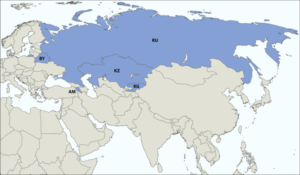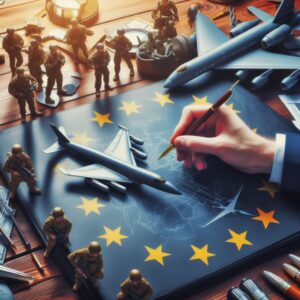The “NATO Strategic Concept” is a document formulated every ten years, with the aim of outlining and formalizing the essential security goals and duties of the military alliance.
In the document formulated in 2010, the military alliance cited Russia as a “strategic partner”. However, in the current document, prepared in Madrid in June 2022, NATO points to Russia as the biggest threat to its existence.
In the 2010 Strategic Concept, China was not mentioned. As early as June 2022, the country was described as a challenge to the “interests, security and values” of the allies, according to Politico. Furthermore, NATO Secretary General, Jens Stoltenberg, says that for the first time the meeting in Madrid will discuss “the challenges that Beijing poses to our security, interests and values”, according to the BBC.

What are the main new elements of the new NATO Strategic Concept of 2022 and other actions to strengthen it?
Meeting in Madrid on 29 June 2022, the Heads of State and Government in NATO specified the three main functions of the alliance: deterrence and defense; crisis prevention and management; and cooperative security.
To that end, NATO has shared its plans to dramatically increase the number of soldiers on high readiness, from 40,000 men to a whopping 300,000 men, and Stoltenberg says that this increase came from a direct Russian threat to European security.
At the summit, it was determined that an American headquarters will be transferred to Poland permanently. In the meantime, additional US warships will be deployed in Spain, more of their fighter jets will be sent to the UK and additional soldiers will leave for Romania.
Joe Biden, US President, asserts that NATO will be “strengthened in all directions and in all domains – land, air and sea”. Biden reaffirmed the pact to “defend every inch” of the alliance’s territory, saying: “By that we mean that an attack on anyone is an attack on everyone.”
According to the BBC, NATO’s new measures include:
- Boost the fleet of US naval destroyers stationed in Spain from four to six;
- An additional “rotational brigade” in Romania, consisting of 3,000 fighters and another 2,000-person combat team;
- Two more squadrons of F-35 stealth jets to the UK;
- Additional air defense and other capabilities in Germany and Italy.
The US 5th Army Corps which is currently based in Fort Knox, Kentucky – USA, will be transferred to Poland soon.
In the meantime, the UK has nearly doubled the size of its military presence in Estonia, with approximately 1,600 troops in the country. In addition, more warships, fighters and ground forces are being made available for alliance defense. However, the UK Defense Minister did not elaborate on the figures, as he declared them to be “military sensitive”.
At the Madrid meeting, the leaders of the United States and the United Kingdom also addressed the Chinese issue with rigidity. They declared that a new “strong” language will be introduced, as they believe that China is a growing threat of attack against the democratic island of Taiwan.
However, France and Germany are proposing to take more restrained measures towards China, according to what NATO diplomats told to Reuters news agency. This more conciliatory attitude of the two main economies of the European Union is mainly due to the desire not to harm trade relations with Beijing.
How did the Russian invasion of Ukraine “backfire” on Putin and strengthen NATO instead of weakening it?
Among the main reasons, defended by Vladimir Putin, for Russia’s invasion of Ukraine are the expansion of NATO in Eastern European countries, the possibility of Ukraine joining the group and Putin’s search for a re-establishment of the former’s zone of influence of the former Soviet Union.
Therefore, Putin would like to prevent a “siege” from forming on the Russian border, which would come even closer with Ukraine’s accession to the alliance. However, the attitude is seen as disrespectful to Ukrainian sovereignty, which should have the right to decide its alliances.
However, “it backfired”, and instead of splitting or weakening NATO – as expected – the reaction provoked was the complete opposite. After the Madrid meeting, the alliance declared Russia “its most direct threat” and member states are going to great lengths to maintain Europe’s security through collaboration with Ukraine, ironically making NATO even stronger and more united.
The greatest example of this inversion of objectives is the adherence of Sweden and Finland to the bloc. After decades of neutrality, the Nordic countries are ready to join the military alliance after Turkey removed its veto on the deal.
In view of this, by trying to avoid a siege on its border and weakening the North Atlantic military alliance, Russia ended up uniting, strengthening and expanding NATO. NATO Secretary General, Jens Stoltenberg, says: “the door is opened and the union of Sweden and Finland will take place”.
From a NATO without American tanks in Europe and “brain death”, according to Macron, to a reinvigorated alliance.
Moscow’s invasion of Ukraine provoked an immediate and coordinated reaction from NATO, reorganizing the alliance that, in 2019, the French President, Emmanuel Macron, claimed it was a “brain death”.
In the same derogatory way, former US President Donald Trump continually contested the value of NATO and even suggested withdrawing the country from the alliance during his tenure.
Unlike Macron, the German Chancellor, Angela Merkel, acknowledges the importance of the alliance saying that “NATO is as important to Germany now as it was during the Cold War” in 2019.
To get an idea of how NATO/US was disengaging from Europe, in 2013, after 69 years of North American history of basing its main tanks in Germany, the last 22 combat embarked back to the US, thus ending their mission on German soil.
Abrams tanks were part of the main defense features during the Cold War and coincided with the inactivation of 2 troop groups – among the strongest in the US Army – in Germany.
At the height of World War II and the Cold War, Germany was home to 20 NATO armored divisions, or approximately 6,000 tanks. Therefore, the US withdrawal of one of its main military systems from the European theater was a historic moment in the decrease of NATO’s presence on the continent.
However, after the Russian invasion of Ukraine, the “rebirth” of NATO is essential for the security of Europe and demonstrates that the military alliance is still necessary and extremely important.
The future trend of NATO, the most powerful military alliance in the human history.
After the lifting of the veto imposed by Turkey on the accession of Sweden and Finland to NATO, the leaders already have a historic result in sight. The green light given by the Turkish President, Erdoğan, opened the door for the countries to strategically join the alliance, creating an even more powerful siege against Russia.
Putin’s strategic mistake left him even more vulnerable in the International System, compromising its military and political stability. With the accession of the Nordic countries, and the greater cooperation between NATO and Ukraine in terms of warfare and intelligence – Russia finds itself increasingly “hanged” and hands tied in the face of its great opposition.
If once Vladimir Putin aimed to increase his influence in the “sphere of influence” of the former Soviet Union, today countries like Estonia, Latvia, Lithuania, Poland, Hungary and the Czech Republic, which traditionally gravitated under Moscow’s orbit of influence, aligned almost completely with the West, perhaps with the exception of Hungary, which is still heavily influenced by Moscow.
The “Iron Curtain” that in the Cold War designated the separation, first ideological and then physical, established in Europe after the Second World War – between the zone of Soviet influence in the East and the countries of the West – fell physically and largely ideologically in 1989 with the Berlin Wall.
However, until recently, political-ideological influence remained rooted in some Eastern European countries. But today, in 2022, some Western countries are returning to containment theories shelved after the end of the Soviet Union.
It is noted that NATO will spare no efforts to maintain security in Europe, contain the Russian escalation in Ukraine and even contain China in Taiwan, gaining an even greater strategic and historic role than originally planned.






日軍第731部隊旧址_PB121201-e1713902593308-300x224.jpg)









[…] alliance, which was supposed to be a rival to the North Atlantic Treaty Organization (NATO), is suffering from the potential evasion of its members and, in September of the same year, faced a […]
[…] Furthermore, regional and energy insecurity and the Chinese economic and military threat also represent significant problems for the EU and NATO, which created its New Strategic Concept. […]